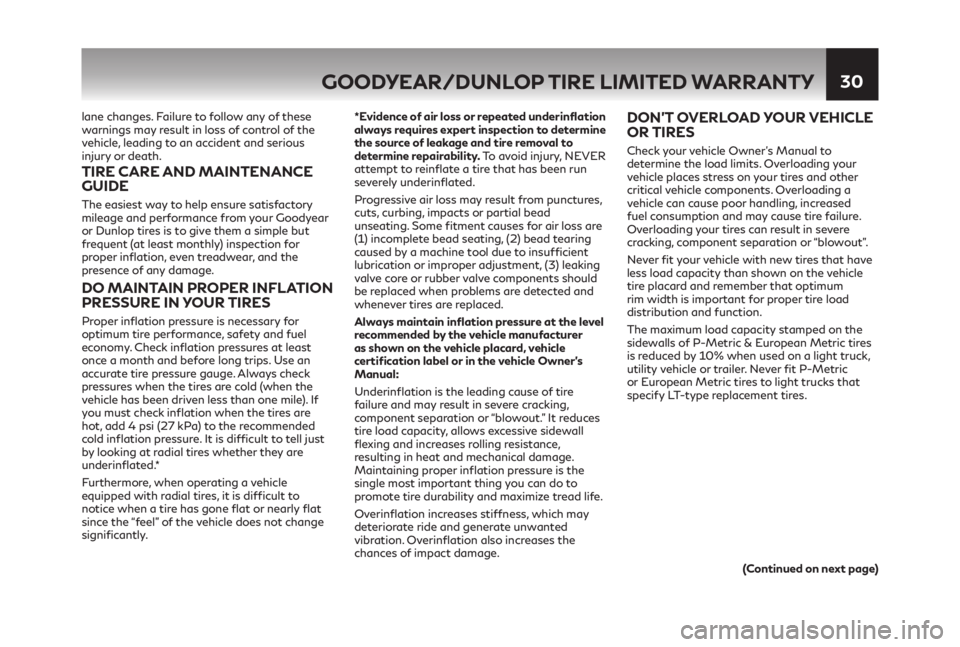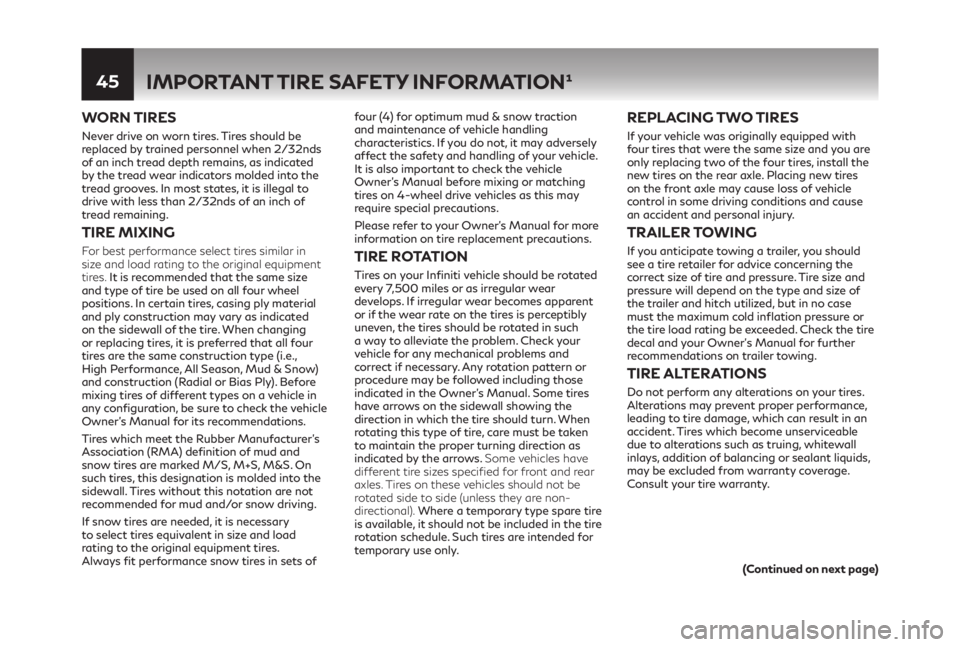trailer INFINITI Q50 2021 Warranty Information Booklet
[x] Cancel search | Manufacturer: INFINITI, Model Year: 2021, Model line: Q50, Model: INFINITI Q50 2021Pages: 54, PDF Size: 0.34 MB
Page 33 of 54

30
lane changes. Failure to follow any of these
warnings may result in loss of control of the
vehicle, leading to an accident and serious
injury or death.
TIRE CARE AND MAINTENANCE
GUIDE
The easiest way to help ensure satisfactory
mileage and performance from your Goodyear
or Dunlop tires is to give them a simple but
frequent (at least monthly) inspection for
proper inflation, even treadwear, and the
presence of any damage.
DO MAINTAIN PROPER INFLATION
PRESSURE IN YOUR TIRES
Proper inflation pressure is necessary for
optimum tire performance, safety and fuel
economy. Check inflation pressures at least
once a month and before long trips. Use an
accurate tire pressure gauge. Always check
pressures when the tires are cold (when the
vehicle has been driven less than one mile). If
you must check inflation when the tires are
hot, add 4 psi (27 kPa) to the recommended
cold inflation pressure. It is difficult to tell just
by looking at radial tires whether they are
underinflated.*
Furthermore, when operating a vehicle
equipped with radial tires, it is difficult to
notice when a tire has gone flat or nearly flat
since the “feel” of the vehicle does not change
significantly. *Evidence of air loss or repeated underinflation
always requires expert inspection to determine
the source of leakage and tire removal to
determine repairability. To avoid injury, NEVER
attempt to reinflate a tire that has been run
severely underinflated.
Progressive air loss may result from punctures,
cuts, curbing, impacts or partial bead
unseating. Some fitment causes for air loss are
(1) incomplete bead seating, (2) bead tearing
caused by a machine tool due to insufficient
lubrication or improper adjustment, (3) leaking
valve core or rubber valve components should
be replaced when problems are detected and
whenever tires are replaced.
Always maintain inflation pressure at the level
recommended by the vehicle manufacturer
as shown on the vehicle placard, vehicle
certification label or in the vehicle Owner’s
Manual:
Underinflation is the leading cause of tire
failure and may result in severe cracking,
component separation or “blowout.” It reduces
tire load capacity, allows excessive sidewall
flexing and increases rolling resistance,
resulting in heat and mechanical damage.
Maintaining proper inflation pressure is the
single most important thing you can do to
promote tire durability and maximize tread life.
Overinflation increases stiffness, which may
deteriorate ride and generate unwanted
vibration. Overinflation also increases the
chances of impact damage.
DON’T OVERLOAD YOUR VEHICLE
OR TIRES
Check your vehicle Owner’s Manual to
determine the load limits. Overloading your
vehicle places stress on your tires and other
critical vehicle components. Overloading a
vehicle can cause poor handling, increased
fuel consumption and may cause tire failure.
Overloading your tires can result in severe
cracking, component separation or “blowout”.
Never fit your vehicle with new tires that have
less load capacity than shown on the vehicle
tire placard and remember that optimum
rim width is important for proper tire load
distribution and function.
The maximum load capacity stamped on the
sidewalls of P-Metric & European Metric tires
is reduced by 10% when used on a light truck,
utility vehicle or trailer. Never fit P-Metric
or European Metric tires to light trucks that
specify LT-type replacement tires.
(Continued on next page)
GOODYEAR/DUNLOP TIRE LIMITED WARRANTY
4303458_21a_INFINITI_US_WIB_032520.indd 304303458_21a_INFINITI_US_WIB_032520.indd 304/8/2020 10:18:18 AM4/8/2020 10:18:18 AM
Page 48 of 54

45
WORN TIRES
Never drive on worn tires. Tires should be
replaced by trained personnel when 2/32nds
of an inch tread depth remains, as indicated
by the tread wear indicators molded into the
tread grooves. In most states, it is illegal to
drive with less than 2/32nds of an inch of
tread remaining.
TIRE MIXING
For best performance select tires similar in
size and load rating to the original equipment
tires. It is recommended that the same size
and type of tire be used on all four wheel
positions. In certain tires, casing ply material
and ply construction may vary as indicated
on the sidewall of the tire. When changing
or replacing tires, it is preferred that all four
tires are the same construction type (i.e.,
High Performance, All Season, Mud & Snow)
and construction (Radial or Bias Ply). Before
mixing tires of different types on a vehicle in
any configuration, be sure to check the vehicle
Owner’s Manual for its recommendations.
Tires which meet the Rubber Manufacturer’s
Association (RMA) definition of mud and
snow tires are marked M/S, M+S, M&S. On
such tires, this designation is molded into the
sidewall. Tires without this notation are not
recommended for mud and/or snow driving.
If snow tires are needed, it is necessary
to select tires equivalent in size and load
rating to the original equipment tires.
Always fit performance snow tires in sets of four (4) for optimum mud & snow traction
and maintenance of vehicle handling
characteristics. If you do not, it may adversely
affect the safety and handling of your vehicle.
It is also important to check the vehicle
Owner’s Manual before mixing or matching
tires on 4-wheel drive vehicles as this may
require special precautions.
Please refer to your Owner’s Manual for more
information on tire replacement precautions. TIRE ROTATION
Tires on your Infiniti vehicle should be rotated
every 7,500 miles or as irregular wear
develops. If irregular wear becomes apparent
or if the wear rate on the tires is perceptibly
uneven, the tires should be rotated in such
a way to alleviate the problem. Check your
vehicle for any mechanical problems and
correct if necessary. Any rotation pattern or
procedure may be followed including those
indicated in the Owner’s Manual. Some tires
have arrows on the sidewall showing the
direction in which the tire should turn. When
rotating this type of tire, care must be taken
to maintain the proper turning direction as
indicated by the arrows. Some vehicles have
different tire sizes specified for front and rear
axles. Tires on these vehicles should not be
rotated side to side (unless they are non-
directional). Where a temporary type spare tire
is available, it should not be included in the tire
rotation schedule. Such tires are intended for
temporary use only.
REPLACING TWO TIRES
If your vehicle was originally equipped with
four tires that were the same size and you are
only replacing two of the four tires, install the
new tires on the rear axle. Placing new tires
on the front axle may cause loss of vehicle
control in some driving conditions and cause
an accident and personal injury.
TRAILER TOWING
If you anticipate towing a trailer, you should
see a tire retailer for advice concerning the
correct size of tire and pressure. Tire size and
pressure will depend on the type and size of
the trailer and hitch utilized, but in no case
must the maximum cold inflation pressure or
the tire load rating be exceeded. Check the tire
decal and your Owner’s Manual for further
recommendations on trailer towing.
TIRE ALTERATIONS
Do not perform any alterations on your tires.
Alterations may prevent proper performance,
leading to tire damage, which can result in an
accident. Tires which become unserviceable
due to alterations such as truing, whitewall
inlays, addition of balancing or sealant liquids,
may be excluded from warranty coverage.
Consult your tire warranty.
(Continued on next page)
IMPORTANT TIRE SAFETY INFORMATION¹
4303458_21a_INFINITI_US_WIB_032520.indd 454303458_21a_INFINITI_US_WIB_032520.indd 454/8/2020 10:18:19 AM4/8/2020 10:18:19 AM